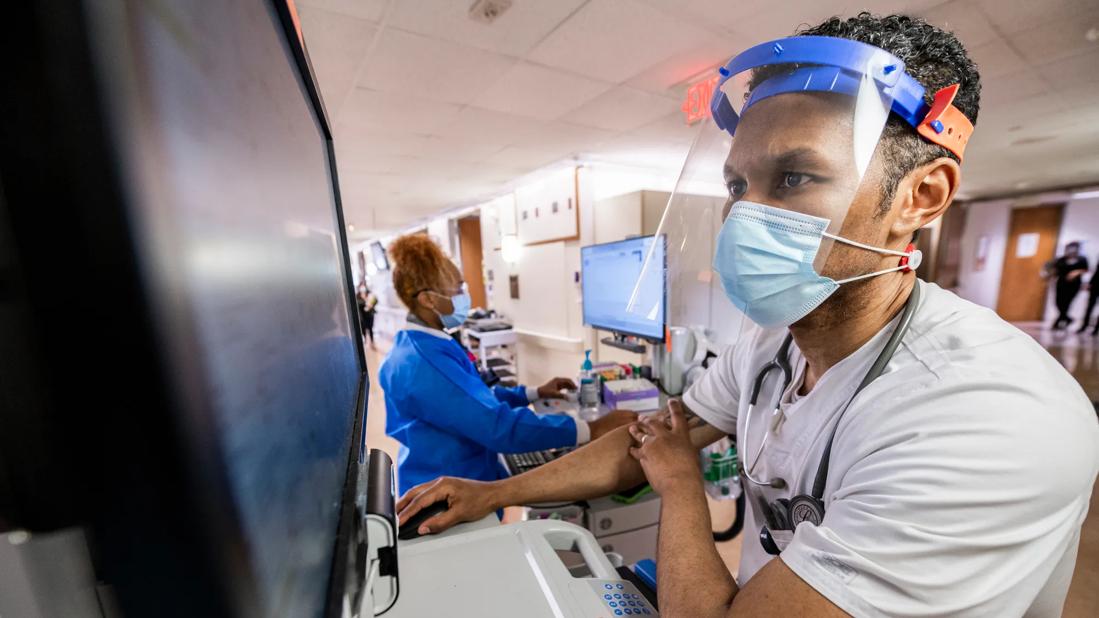Cleveland Clinic helps establish standards of care for yielding best outcomes

The fast-moving spread of SARS-CoV-2 and a host of mysteries about how this novel virus behaves have challenged clinicians working to give patients the best possible care. In a recent issue of the Cleveland Clinic Journal of Medicine, Cleveland Clinic physicians outlined recommendations for the management of care for those hospitalized with COVID-19.
Published as part of the journal’s Curbside Consult series, “The hospitalized patient with COVID-19 on the medical ward: Cleveland Clinic approach to management” reviews research and describes effective protocols. As new evidence emerges, it will be crucial for caregivers to stay agile and up-to-date, write authors Maria Miklowski, MD; Bruce Jansen, MD; Moises Auron, MD; and Christopher Whinney, MD.
Advertisement
Cleveland Clinic is a non-profit academic medical center. Advertising on our site helps support our mission. We do not endorse non-Cleveland Clinic products or services. Policy
Although no firm guidelines have been set for whether or when to admit patients to the hospital, the authors acknowledge that factors to be considered might include hospital capacity, availability of resources and spread of the virus in the community. Cleveland Clinic admits those who exhibit signs of moderate to severe disease, they write. Symptoms may include hypoxia, high fevers, diarrhea, altered mental status, failure to thrive and inability to manage their own care.
During admission, patients should be tested for COVID-19, but suspicion of infection may arise through presentation of symptoms and other laboratory indicators, including lymphopenia, leukocytosis, elevations in aspartate aminotransferase, alanine aminotransferase, C-reactive protein, erythrocyte sedimentation rate, and D-dimer and a low to normal procalcitonin level. Ground-glass opacities that appear on chest imaging may indicate that the patient should be considered under investigation for infection and placed in isolation until the return of results from the screening.
The authors emphasize the importance of centralizing care, which optimizes support for caregivers and connects patients to providers with specialized COVID-19 training and experience.
Specialized units established for COVID-19 patients also can help reduce risk of transmission of the disease elsewhere in the hospital. Teams comprising physicians, nurses, nurse’s aides, respiratory therapists, advance-practice providers, dietary staff and environmental services professionals serve these patients well through the development of expertise in their care.
The authors offer additional recommendations regarding personal protective equipment (PPE) and the importance of having a timely discussion of code status, and include an index of orders for laboratory monitoring.
Advertisement
Use of nebulized bronchodilators is not recommended because of the risk of aerosolizing the virus, but the authors suggest that in some cases it may be practical to allow patients to keep inhalers at the bedside.
A World Health Organization review has dispelled early concerns from the Health Minister of France about the use of nonsteroidal anti-inflammatory drugs (NSAIDs) among COVID-19 patients, but acetaminophen remains preferred for controlling fever because of risks that NSAIDs pose for bleeding, renal compromise and gastrointestinal complications. The authors also cite multiple medical associations that — despite initial questions about the use of angiotensin converting enzyme (ACE) inhibitors and angiotensin II receptor blockers (ARBs) with COVID-19 patients — encourage continuing these where prescribed except in the presence of contraindications.
The review also addresses the use of statins and antibiotics, and the importance of glycemic control.
Recommendations for overall support focusing on respiratory, cardiac and circulatory functions, include:
Cleveland Clinic prescribes the glucocorticoid dexamethasone to all inpatients who require supplementary oxygen. The review cites the Randomized Evaluation of Covid-19 Therapy trial in the United Kingdom, which compared dexamethasone administered intravenously or by mouth to the usual care in hospitalized patients receiving no supplemental oxygen, oxygen, or mechanical ventilation. The 28-day mortality rate was lower in those receiving dexamethasone, with the difference most pronounced in those on mechanical ventilation (29.3% vs 41.4%), followed by those receiving supplemental oxygen (23.3% vs 26.2%). For those who were not receiving supplemental oxygen, the mortality rate was higher with dexamethasone than without it, but the difference was not statistically significant (17.8% vs 14%).
Advertisement
Use of the antiviral remdesivir has been shown to speed recovery and improve clinical condition among COVID-19 patients, especially when administered to those with mild to moderate illness during the first 10 days after the onset of symptoms. The United States Food and Drug Administration has approved remdesivir for all hospitalized COVID-19 patients, although Cleveland Clinic requires its use to be decided on a case-by-case basis.
With regard to the use of convalescent plasma, garnered from recovered patients who have detectable antibodies against SARS-CoV-2, the authors note that more evidence is needed to determine potential benefits. Cleveland Clinic requires an infectious disease consult before the use of convalescent plasma.
The review includes guidelines around criteria for discharge, the importance of working with case managers and social workers for those who need post-hospital care in long-term care facilities, and an overview of Cleveland Clinic’s home-monitoring program.
The full review can be read here.
Advertisement
Advertisement

Patients report improved sense of smell and taste

Clinicians who are accustomed to uncertainty can do well by patients

Unique skin changes can occur after infection or vaccine

Cleveland Clinic analysis suggests that obtaining care for the virus might reveal a previously undiagnosed condition

As the pandemic evolves, rheumatologists must continue to be mindful of most vulnerable patients

Early results suggest positive outcomes from COVID-19 PrEP treatment

Could the virus have caused the condition or triggered previously undiagnosed disease?

Five categories of cutaneous abnormalities are associated with COVID-19